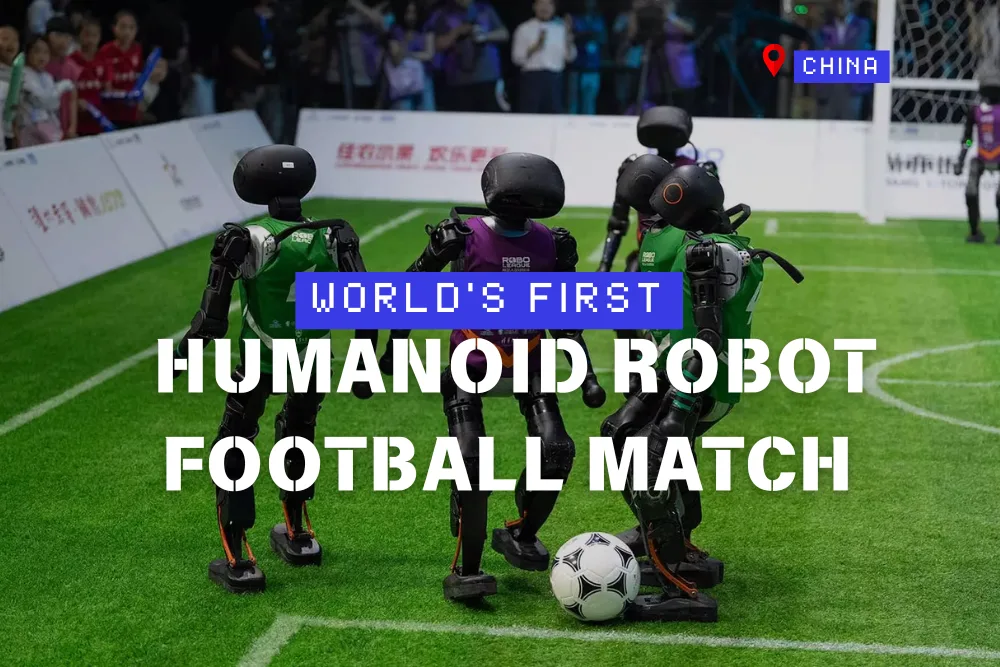Now Reading: World’s First Humanoid Robot Football Match
-
01
World’s First Humanoid Robot Football Match
World’s First Humanoid Robot Football Match

As the world’s top football clubs compete in the Club World Cup in the United States, a groundbreaking parallel event has captured global attention—China has hosted the world’s first humanoid robot football match. This match was played entirely by humanoid robots powered by artificial intelligence (AI). The event marks a significant leap forward in robotics and AI integration in real-world scenarios, especially in sports.
Held in Beijing, the historic match featured four teams of fully autonomous humanoid robots, each team comprising three players. The match was structured into two 10-minute halves with a five-minute halftime break. Unlike previous robotic sports showcases that required some level of human control or oversight, this match was completely unsupervised, allowing AI systems to independently manage player movement, ball tracking, decision-making, and even post-fall recovery.
AI on the Field: Coordination, Strategy, and Agility
The robots exhibited remarkable real-time capabilities. They were not only able to track and chase the ball accurately but also demonstrated advanced strategic decision-making, such as when to pass, defend, or take a shot. Most impressively, the robots showed signs of team coordination, with some AI systems assigning temporary roles like goalkeeper or striker based on in-game needs. Even after slipping or falling, the robots could self-correct and return to the match—a milestone in bipedal robot mobility.
Event organizers described the match as more than just a competition. It was a technological demonstration designed to make robotics more accessible to the public and encourage cross-disciplinary innovation. According to the organizing committee, “This is a domestic first, but more importantly, it opens a window to bring robots closer to society and real-life applications.”
The Future of Human-Robot Football?
Looking ahead, developers are envisioning mixed matches between humans and robots. Such games, they say, wouldn’t prioritize scoring or victory, but rather focus on demonstrating safe physical interaction, trust-building, and entertainment. “Imagine a friendly match where a human and a robot engage in real-time offense and defense,” said one of the lead engineers.

China’s Bold Leap in Robotics
This robotic football match is just one example of China’s rapid investment in AI and robotics. According to a 2025 report by Morgan Stanley, the Chinese robotics market is projected to more than double by 2028, surging from $47 billion to $108 billion. Sectors such as manufacturing, healthcare, education, and now sports, are becoming crucial testing grounds for AI applications.
China’s commitment to robotic sports is further underscored by the announcement of the 2025 World Humanoid Robot Sports event, set to take place this August. It will be the first global sports tournament exclusively for humanoid robots, featuring not just football, but also track and field, gymnastics, and even robotic martial arts. Countries around the world are expected to participate, turning it into a landmark event in AI-driven athleticism.
A New Chapter in Sports Innovation
The world’s first AI-powered humanoid robot football match is more than a novelty—it symbolizes a shift in how we imagine the future of sports, human-machine collaboration, and intelligent automation. While today’s robotic footballers are still far from matching Lionel Messi or Kylian Mbappé, they represent a growing field where AI, robotics, and entertainment converge.
As audiences continue to marvel at human talent in global tournaments, the rise of AI athletes invites a new question: What does it mean to be a player in the age of intelligent machines? With China leading the charge, we may soon find out.
Find more AI news from Search Ethics.
Dony Garvasis is the founder of Search Ethics, a platform dedicated to transparency, authenticity, and ethical digital practices. With over six years of experience in SEO and digital marketing, I provide expert content on automobiles, Artificial intelligence, technology, gadgets, science, tips, tutorials and much more. My mission is simple: Ethical Search, Genuine Results! I will make sure people everywhere get trustworthy and helpful information.










